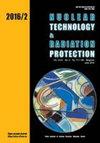腰椎侧位照相不同幻位对选定器官有效剂量和吸收剂量的影响
IF 0.9
4区 工程技术
Q3 NUCLEAR SCIENCE & TECHNOLOGY
引用次数: 0
摘要
本研究旨在探讨患者在腰椎x线摄影时不同的左右侧卧位及其对选定器官有效剂量和吸收剂量的影响。研究是在西门子Multix/Vertix x射线设备上进行的,使用爱克发的计算机放射照相系统。在79 kV至90 kV的管电压下,对两个拟人幻影(PBU 60和RS 113T)进行侧位成像。剂量是用放置在x射线装置准直器下的DAP计测量的。使用蒙特卡罗模拟程序pcxmc2.0计算了所选器官的有效剂量和吸收剂量。基于蒙特卡罗模拟计算,PBU 60幻象的有效剂量降低了15.2%,RS 113T幻象的有效剂量降低了14.2%,有利于右侧投影。对选定器官的吸收剂量显示,淋巴结、胰腺、小肠、脾脏和胃的剂量明显减少,有利于该投影。基于以上结果,我们可以得出结论,在腰椎侧位投影成像时应选择右侧侧位投影方法。本文章由计算机程序翻译,如有差异,请以英文原文为准。
Effect of different phantom positions in lateral lumbar spine radiography on effective dose and absorbed dose to selected organs
This study aimed to investigate the different positioning of the patient in left and right lateral position during lumbar spine radiography and its effects on effective dose and absorbed dose for selected organs. The study was performed on a Siemens Multix/Vertix X-ray unit using Agfa's computer radiography system. Two anthropomorphic phantoms (PBU 60 and RS 113T) were imaged in both lateral projections with a tube voltage from 79 kV to 90 kV. The dose was measured with a DAP meter placed under the collimator of the X-ray unit. The effective dose and absorbed dose for selected organs were calculated using the Monte Carlo simulation programme PCXMC 2.0. Based on Monte Carlo simulation calculations, the results of effective dose on a PBU 60 phantom showed a decrease of 15.2%, while the decrease in effective dose on a RS 113T phantom was 14.2% in favour of the right lateral projection. An absorbed organ dose to selected organs showed a significant dose reduction for lymph nodes, pancreas, small intestine, spleen, and stomach in favour of this projection. Based on the results, we can conclude that right lateral projection should be the method of choice when imaging the lumbar spine in the lateral projection.
求助全文
通过发布文献求助,成功后即可免费获取论文全文。
去求助
来源期刊

Nuclear Technology & Radiation Protection
NUCLEAR SCIENCE & TECHNOLOGY-
CiteScore
2.00
自引率
41.70%
发文量
10
审稿时长
6-12 weeks
期刊介绍:
Nuclear Technology & Radiation Protection is an international scientific journal covering the wide range of disciplines involved in nuclear science and technology as well as in the field of radiation protection. The journal is open for scientific papers, short papers, review articles, and technical papers dealing with nuclear power, research reactors, accelerators, nuclear materials, waste management, radiation measurements, and environmental problems. However, basic reactor physics and design, particle and radiation transport theory, and development of numerical methods and codes will also be important aspects of the editorial policy.
 求助内容:
求助内容: 应助结果提醒方式:
应助结果提醒方式:


